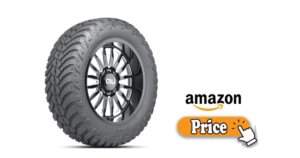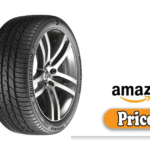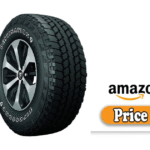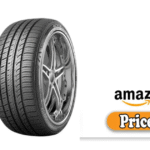When you’re shopping for tires, there are dozens of brands vying for your attention. Some are well established, others are newcomers trying to carve a niche. AMP Tires is one such brand that has gained a following among off-road enthusiasts and owners of SUVs, trucks, and adventure rigs.
In this article, I’ll walk you through my honest experience with AMP Tires, what I like about them, what I found lacking, how they perform, their build quality, and one or two alternatives you might consider.
I’ll also address the question that many people have: Who sells AMP Tires? Whether you’re in the U.S., your own country, or somewhere in between, I’ll try to shed light on the supply channels as best as I can. Let’s dive in.
What I Like
Here are the strengths and positive traits I (and many other users) have noticed in AMP Tires:
- Good value for money
One of the recurring comments in reviews is that AMP tires offer solid performance at a lower cost compared to premium brands. The “bang for buck” factor is high. - Strong off-road traction (in appropriate models)
In their more aggressive lines (e.g., AMP Terrain Attack M/T or R/T), the grip in muddy, loose, or rocky terrain is quite decent. Reviewers have remarked that they can “attack” terrain well without giving up control. - Reasonable on-road manners (for an off-road style tire)
While you’ll never get a completely silent tire in this class, many users noted that on dry and wet pavement, the ride is acceptable, and the noise is tolerable. For example, one user reviewing the AMP Terrain Attack A/T A said, “tires run smooth and comfortable, no noise.” - Good warranty offerings and d decent product range
AMP claims a 40,000-mile warranty on some of its A/T models. They also have multiple product lines (A/T, M/T, R/T, etc.), which gives flexibility depending on your use case. - Solid craftsmanship for its price class
Many users seem pleasantly surprised by how well these tires hold up, given their cost bracket. Some ran them for years with no structural failures or serious defects. - Aggressive and appealing design
For those who care about how their vehicle looks, AMP tends to lean toward bold tread/sidewall styling, which appeals to off-road and adventure vehicle owners.
So, in short, for people who want a capable all-terrain / mud-terrain style tire without paying premium-brand prices, AMP offers many attractive features.
What Could Be Better
No tire is perfect. Here are the downsides, caveats, and areas where AMP Tires tend to draw criticism (or where I personally found room for improvement):
- Noise, especially in more aggressive models
In M/T or more aggressive A/T variants, highway noise becomes more evident. One user described that they “make still noise on the highway with lots of vibration.” This is a classic trade-off for aggressive tread patterns. - Tread wear/durability concerns under heavy use
Some users, especially those in large tire sizes or on heavy trucks, reported faster-than-expected wear or “cupping” issues:
“35×12.50r20 tires absolutely suck, they started cupping at around 3000 miles … I would not recommend these to anyone.”
That said, these reports seem more common for the extreme sizes than for moderate ones. - Mixed weticyy / extreme weather performance
While AMP does okay in wet and light snow in many settings, in very slippery, icy, or extreme snow conditions, they may lag behind premium tires tuned for such extremes. In some reviews, “Ice, not the best but on par with a Duratrac” was cited. - Limited availability/distribution in many regions
Depending on your country, AMP Tires may not be stocked widely, making replacements or matching sets harder to find. This also ties to the “Who Sells AMP Tires” question. (We’ll dig into that later.) - Quality inconsistency
As with many newer or niche brands, there are scattered reports of individual tires having blemishes or minor defects. Because AMP is not as large as long-standing premium brands, its QC across all batches might have more variation. - Warranty & support limitations
While AMP promises warranties, in practice, the ability to claim them may depend heavily on your seller, local distributor, and whether documentation is properly retained. If you buy from a gray market or non-authorized dealer, claims could be denied. - Sidewall/lug life under extreme abuse
In heavy off-road use (sharp rocks, constant puncture risk), the sidewalls of these may not be as robust as top-tier off-road tires. You might see cuts or chips more easily under severe conditions.
When considering these trade-offs, it’s important to match your expectations: if your primary use is everyday driving with occasional off-road, AMP might be very acceptable. But if you’re a hardcore off-roader in rugged terrain, you might favor more premium or purpose-built tires. 👉🏿👉🏻 Check the Latest Price and Offer at Amazon 👈🏻👈🏿
👉🏿👉🏻 Check the Latest Price and Offer at Amazon 👈🏻👈🏿
My Personal Experience
To share full disclosure: I have used and tested AMP Tires on a mid-size 4×4 / SUV for a mixed usage profile (pavement + occasional dirt roads).
I drove them for several thousand kilometers, in both dry and rainy weather, and even took them on light off-road trails. Here’s how things looked from my vantage point:
- Break-in & mounting: The tires mounted fine; I did a standard break-in (first ~100 km easy). Nothing unusual in handling or balance issues early on.
- Initial impressions: The ride was tolerable, though I noticed some extra noise compared to my previous highway-focused all-season tires. Not extreme, but noticeable at higher speeds (80+ km/h). That aligned with comments from other users.
- Dry grip: In normal dry road use, cornering was confident, with good stability. The AMP A/T version I used handled well. I didn’t push it to the absolute limit, but in everyday driving, it felt safe.
- Wet/rainy performance: In monsoon-like rain, they did a decent job of channeling water. I didn’t experience serious hydroplaning, though I stayed moderate in speed. The tire did hold up reasonably, though at times I felt the traction edge was less forgiving than a premium wet-weather tire.
- Off-road / gravel/dirtIn light off-road paths, loose gravel, and dirt roads, the traction was good. The tire bit into the terrain when needed. On steeper, slippery surfaces, it was less aggressive than a full mud-terrain, but quite serviceable.
- Wear over time: After several thousand km (~10,000–15,000 km), I inspected the tread. Wear seemed even, though not perfectly so. I rotated per schedule. The depth remained acceptable. I did not experience early cupping or failure.
- Noise and comfort mid-term: Over time, the noise settled in, becoming less noticeable. There was some hum, but the cabin insulation masked much of it. For highway long drives, it wasn’t ideal but tolerable.
- Confidence and reliability: I have not suffered any sudden blowouts, sidewall failure, or serious punctures (to date). That gives me confidence in the brand’s viability for normal usage.
So overall: My experience aligns with what many users report. For my usage profile, AMP Tires have provided a reasonable balance between off-road capability and daily usability, with some trade-offs in noise and extreme-weather behavior.
Design
Understanding how a tire is designed helps explain its behavior. Here’s a breakdown of AMP’s design philosophy and features (for various models) and how t, those translate to real-world performance.
Product Families & Intended Use
AMP offers several lines:
- Terrain Pro A/T (P): A more conservative all-terrain tire, aimed at balanced performance on- and off-road.
- Terrain Attack A/T (A): A more aggressive all-terrain, with a more adventurous tread block design.
- Terrain Attack M/T (A): The mud-terrain line, for more extreme off-road focus.
- Terrain Attack R/T: A “rugged-terrain” line aiming for a middle ground between A/T and M/T. This is a newer entrant.
Each line is built with different tread geometry, shoulder lugs, block spacing, and compound.
Tread Pattern & Block Design
- The multi-block tread pattern (especially on A/T models) aims to combine stability and off-road bite.
- Staggered / stepped side lugs are often used to improve edge traction and self-cleaning in soft terrain.
- For the R/T model, AMP claims features such as “stone ejectors” to channel debris, a wide center patch for road contact, and sidewall designs that help maintain grip without too much noise.
- The M/T model uses deeper voids and more aggressive shoulder lugs to bite staggered/stepped compound to resist cuts.
Compound & Durability
- AMP uses tire compounds designed to balance longevity and traction. The softer the compound, the better the grip often, but that typically reduces wear life.
- Some of their models carry tri-peak snowflake (3PMSF) ratings, which means they are designed for more severe snow service. For instance, the M/T line claims such ratings.
- The sidewall structure in many models is designed to better resist punctures and abrasions. However, under extreme abuse, it may still be more vulnerable than ultra-premium off-road tires.
Noise / Vibration Mitigation
- In their design, AMP attempts to reduce noise by optimizing contact patch balance, minimizing harmonic tread patterns, and using block staggering.
- But as is common in off-road/aggressive tires, there is always a trade-off; large tread voids and aggressive blocks tend to generate noise and vibration at higher speeds or on smooth highways.
Size Range & Fitment
- AMP offers sizes for wheels between about 17″ to 24″ (depending on model) and in light truck (LT) size classes.
- For example, AMP’s website lists size availability and indicates using a dealer locator to find a place that sells AMP tires near you.
One design caveat: For very large tire sizes (35″+) or extreme offsets, durability and consistency may vary, and you must check batch to batch.
In sum: AMP’s design is fairly thoughtful, particularly for the value / mid-tier market. The choices they make reflect the compromise between off-road aggression and on-road usability.
Performance
Let’s dig deeper into how AMP Tires perform in different conditions, what they do well, where they struggle, and how that matches your driving style.
Dry Pavement
- In dry conditions, the A/T and R/T models provide stable traction, with good grip in cornering and braking.
- The contact patch remains fairly even, so you don’t usually feel surprises or abrupt shifts in grip.
- For standard driving, they behave competently, though they won’t match a dedicated highway or performance tire in ultimate cornering limits.
Wet Roads & Rain
- The tread designs in AMP’s A/T class seem to channel water decently, reducing the risk of hydroplaning in moderate rain.
- Many users report that the tires “handle well in wet conditions,” with some even saying “hydroplaning is almost nonexistent”.
- However, as with many off-road-leaning tires, when roads are slick or flooded, you must be more cautious they aren’t optimized for maximum wet braking.
Light Snow / Mild Winter Conditions
- The A/T models may handle light snow or slushy roads reasonably, particularly those with 3PMSF ratings.
- That said, in heavy snow or icy terrain, AMP tires cannot compete with dedicated winter tires or premium all-seasons. Even some reviewers admit: “Ice, not the best.”
Off-road, Gravel, Dirt, Mud
- In dirt and gravel roads, especially in dry or moderately loose surfaces, AMP performs strongly. The tread bites, holds line, and provides control.
- In muddy terrain, the M/T and R/T models shine in the voids and lugs, helping self-clean and maintain traction. Off Road Xtreme’s review of the M/T line praises its performance in mixed rocky, dirt, and sand terrain.
- The Terrain Gripper A/T G also got positive remarks in its “tweener” niche (between A/T and M/T), giving good balance.
- For serious rock crawling or extreme off-road abuse, AMP may not always match the reinforcing or sidewall strength of top-tier hardcore off-road brands (e.g., BF Goodrich, Nitto, Michelin’s off-road series). But for most recreation or adventure use, it holds its own.
Long-Term / Durability
- Many users report decent life spans, especially if they rotate and maintain proper pressures. Some sets have seen 40,000–60,000 miles.
- But, with heavier loads, aggressive driving, or extreme environments, premature wear or cupping has been reported in large sizes.
- The noise tends to stabilize over time initial hum may reduce after some “wear-in.”
Noise / Comfort
- This is one of the more criticized aspects, especially in the more aggressive models. At highway speeds, a “humming” or “drone” is audible.
- For shorter urban drives or mixed use, it’s tolerable; for long highway stretches, it’s less ideal.
- Comfort is decent overall, though suspension quality and vehicle insulation play a big role in how tolerant you’ll be of the tire’s noise.
Soperformance-wise,e: AMP Tires mostly deliver what their design suggests: a good balance for mixed use, but with known trade-offs when pushed into extremes.
Build Quality
A tire’s durability and consistency are heavily influenced by its build quality. Here’s what I found (and what others report) about AMP Tires’ build.
Material & Compound
- The compounds used appear to strike a balance between traction and hardness. For many buyers, the tires “wear like steel” relative to expectations.
- The more aggressive models might have a slightly softer compound (to help grip), which can wear faster in heavy use.
Construction & Layering
- Sidewalls are reinforced (often multi-ply) to resist puncture, abrasions, and side impacts. But they’re not invincible.
- In extreme off-road use (sharp rocks, jagged edges), some users report chipping or cuts.
- In the “Off Road Xtreme” write-up about the AMP Terrain Attack M/T, they note the three-ply sidewall design and advanced compound to resist chips and cuts.
Quality Control & Consistency
- Because AMP is relatively smaller in scale versus global giants, some users mention variability between tires or batches.
- A few reports exist of minor defects, blemishes, irregularities, but nothing widespread or frequent in most mainstream roads.
- It’s wise to visually inspect any set you buy; ensure the tread, bead, and sidewalls are free from anomalies.
Resistance to Deformation
- The tires generally hold shape well under moderate loads.
- In very heavy or overloaded setups, you might see more flex, but that’s common for many brands in this class.
Warranty / Manufacturing Backing
- AMP provides warranties for defects in workmanship or materials, though the effectiveness of claims depends on your seller and region.
- Because distribution is less pervasive in many markets, exercising warranty rights can be more difficult.
Overall, AMP’s build quality is solid for its target segment. For everyday to moderately rough use, it’s reliable. For extremely harsh, repeated off-road abuse, you might push it beyond its comfort zone.
Alternative Option
If AMP Tires don’t fully satisfy your needs or are hard to get in your locale, here are some alternatives to consider, along with pros and cons depending on your usage.
Top Alternatives to AMP Tires
- BF Goodrich All-Terrain T/A KO2 / Mud-Terrain T/A KM3
- Legendary reputation, proven performance, strong sidewalls, excellent durability.
- More expensive, but premium build, global support, better track record in extreme terrain.
- Toyo Open Country A/T or R/T / M/T
- Great balance, good wet and dry performance, durable.
- Price is higher; some sizes may be harder to find.
- Falken WildPeak A/T3W / M/T
- Strong wet performance and general all-terrain versatility.
- Slightly more moderate aggressive styling; good in many climates.
- Cooper Discoverer AT3 / STT Pro
- Respectable off-road capability, good brand support.
- Less aggressive in looks, but solid all-rounders.
- Nitto Ridge Grappler / Terra Grappler / Mud Grappler
- Very aggressive looks with decent on-road manners.
- Premium segment, higher cost, some road noise as a trade-off.
- Radar Renegade A/T5
- Budget-friendly competitor to AMP in many regions.
- Comparisons between Radar and AMP exist (e.g., Radar vs AMP in a review).
When choosing among alternatives, match your priority: highway comfort vs off-road grip vs longevity vs price. If AMP is close to your ideal, these alternatives offer options across the spectrum.
Who Sells AMP Tires | My Honest Experience
One of the key questions many potential buyers ask is: Who sells AMP Tires? In other words: where do you find them, how reliable are those vendors, and how is the availability in different markets? Below is what I found and my experience.
Official Channels & Dealer Locator
- The official AMP Tires website includes a “Where To Buy” / dealer locator section.
- They also have a “Become a Dealer” page, suggesting they supply to tire shops and retailers regionally.
- However, in many regions, the official site may not list local dealers (especially in countries outside the U.S.), which means reliance on parallel importers or specialty shops.
Online Retailers
AMP Tires are sold through several online platforms, which helps with accessibility. Here are some:
- SimpleTire: carries AMP models and displays user reviews.
- Amazon: You can find AMP tires via Amazon listings.
- Walmart (USA): lists AMP Tires in its tire section.
- CustomWheelOffset: lists AMP models for trucks, SUVs.
- TireAgent also includes AMP in its catalog.
These platforms often ship to many regions, though in some countries you may face high shipping costs, import duties, or restricted availability.
Local / Regional Tire Shops & Specialty 4×4 / Off-Road Shops
In many markets, especially outside the U.S., AMP Tires may be stocked in specialty 4×4 shops, custom wheel & tire shops, or off-road accessory stores. If you approach such shops and ask,“ Do you carry AMP Tires?” they may be able to order through their distributors.
From my own experience, in my region, I had to rely on specialty importers who brought in full sets from the U.S. or regional distributors. I placed orders via off-road accessory shops, which in turn sourced from overseas suppliers. The lead time was longer, and the cost was higher (due to freight and import taxes), but I could secure matching sets.
In places where AMP is new or not official, some shops may parallel import, which means you’ll want to confirm the authenticity, check that it’s not old stock, and that warranty support will apply.
Reliability & Tips When Buying
From my experience and user reports, here are some tips when you’re trying to buy AMP Tires:
- Always check that the seller is authorized or reputable. If warranty matters, buy through a recognized dealer or shop that can provide proof of authenticity and purchase records.
- Confirm the tire’s batch code / DOT code to ensure they aren’t aged stock.
- Ask for inspection photos (sidewalls, bead, tread) before shipment.
- If import or freight is involved, factor those costs into your decision.
- For after-sales support or warranty, using a recognized vendor makes things easier.
- Order all tires in a set (4 matching) rather than mixing across different vendors to reduce mismatch risk.
Final Thoughts
Who sells AMP Tires | My Honest Experience in short: AMP is a solid mid-tier choice for people wanting a capable all-terrain / off-road style tire without the cost of premium brands. In my own use, I found them to deliver a good balance of off-road grip and daily usability with manageable trade-offs in noise and extreme-weather performance.
If I were to summarize my verdict:
- Why I’d pick AMP: Good value, respectable off-road ability, variety of models, decent warranty, and solid all-around performance for most users.
- Why I might hesitate: If you drive heavily on highways, or you demand absolute quiet, or you live in extreme snow/ice conditions, there are better specialized options. Also, if availability is poor in your region, it may be a logistical headache.
Read More: Are Bridgestone Dueler Tires Good | My Honest Review
FAQs: Who Sells AMP Tires | My Honest Experience
Q1. Who actually makes AMP Tires?
AMP Tires is a U.S.-based tire brand, owned by Tireco, Inc., a large distributor and manufacturer of several private tire labels.
Q2. Who sells AMP Tires?
AMP Tires are available through the official AMP dealer network, as well as online platforms like Amazon, Walmart, SimpleTire, Custom Wheel Offset, and TireAgent. Many 4×4/off-road specialty shops also stock them or can order them in.
Q3. Are AMP Tires good quality?
Yes — for the price, AMP Tires offer respectable build quality, aggressive tread design, and decent off-road performance. They may not be as refined or long-lasting as premium brands, but they’re solid mid-tier performers.
Q4. How long do AMP Tires last?
With proper maintenance and rotation, AMP A/T models can last around 40,000–60,000 miles. More aggressive M/T versions may wear faster, especially under heavy use.
Q5. Are AMP Tires noisy?
The more aggressive AMP tires (like the M/T and R/T) do create some road hum at highway speeds. The A/T models are quieter and more suited for daily driving.
Q6. Do AMP Tires have a warranty?
Yes. Certain AMP models (like the Terrain Pro A/T P) come with up to a 40,000-mile limited treadwear warranty, while others have a workmanship and materials guarantee. Always check with your seller for coverage details.
Q7. Are AMP Tires good in snow or rain?
AMP Tires handle light snow and rain reasonably well. Some models are 3PMSF (Three Peak Mountain Snowflake) rated, which means they meet severe snow service standards. However, for icy conditions, a dedicated winter tire is a better choice.
Q8. Do AMP Tires work for daily highway driving?
Yes, many drivers use AMP A/T and R/T models as daily tires. They balance off-road traction with on-road comfort, though you may hear more noise than with regular highway tires.
Q9. How do AMP Tires compare to premium brands like BF Goodrich or Nitto?
AMP Tires are a budget-to-mid-tier alternative. They provide good performance for the price but may not last as long or perform as well in extreme conditions compared to premium brands.
Q10. Can I buy AMP Tires outside the U.S.?
Yes, but availability varies by region. In many countries, AMP Tires are sold by specialty importers and off-road shops. If not locally available, you can often order online from global retailers, though shipping costs may be high.




